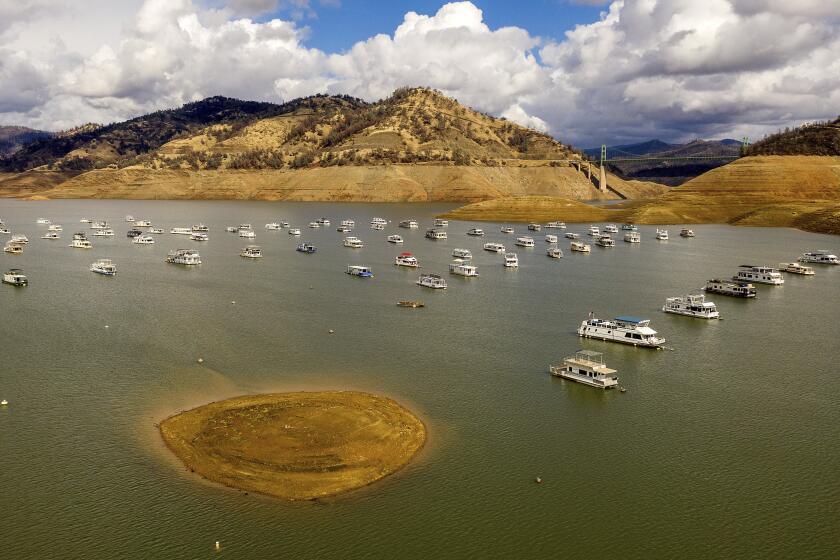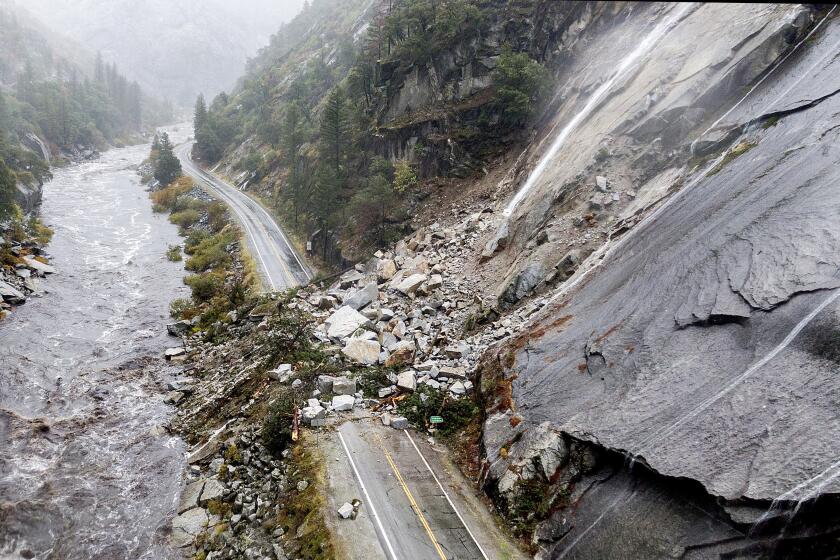Storm shatters rainfall records in Southern California. Who got the most?

The storm that hit Southern California on Monday broke rainfall records as it swept down from the north and delivered much-needed moisture to areas parched by drought.
A low-pressure system hovering some 200 miles off the coast of Seattle sent a cold front hurtling all the way to the Southland, battering the area with significant rain for the first time in seven months.
The storm topped out at a 943-millibar pressure level, which is exceedingly low and signifies “a very intense storm,” said David Sweet, a meteorologist with the National Weather Service in Oxnard.
“Seeing that in October is very impressive,” he said.
Some Los Angeles County metro and coastal areas recorded more than an inch of rain. Just under half an inch fell over downtown L.A., according to the National Weather Service. Beverly Hills recorded 1.12 inches and Bel Air got 1 inch.
Several foothill communities saw even more moisture, with East Pasadena and nearby La Cañada-Flintridge both receiving 1.32 inches.
The mountains in particular were pummeled by precipitation, getting more than 5 inches in some spots.
Opids Camp, a typically rainy spot perched roughly 3,600 feet above Pasadena, recorded 2.63 inches of rain. San Marcos Pass in Santa Barbara County’s Santa Ynez Mountains saw 4.54 inches. Rocky Butte, tucked in the Santa Lucia Mountains of northwestern San Luis Obispo County, was walloped with 5.71 inches — the highest amount recorded in the forecast area.
Weather officials were bracing for the downpour, and “it basically delivered on what was expected,” Sweet said.
Several records were shattered by the powerful storm, noted for its intense strength and relatively early arrival in the rainy season.
Los Angeles International Airport recorded 0.39 inches, breaking the daily record of 0.19 inches set in 1951. A record rainfall of 0.13 inches was also set at Long Beach Airport, surpassing the daily record of 0.08 inches set in 2010. Camarillo Airport reported 0.7 inches, which broke the previous daily high of 0.39 inches recorded in 1940.
Paso Robles Airport, which recorded 1.54 inches, smashed its record of 0.18 inches set in 1950. Santa Maria Airport similarly crushed its record after receiving 1.28 inches, surpassing the 0.3 inches that fell in 1951.
Powered by a fierce atmospheric river, the storm wreaked havoc in Northern and Central California over the weekend before pushing into the southern part of the state.
Some northern areas were pummeled with up to 10 inches of rain, and records were shattered there as well.
A massive storm barrels toward Southern California after causing flooding and mud flows in areas burned by wildfires across Northern California.
Downtown Sacramento reported a record 24-hour rainfall total of 5.44 inches, surpassing a mark set in 1880, the National Weather Service said.
City officials said the precipitation totals represented even more than a “200-year storm level,” which occurs at 4.6 inches and has a 0.5% chance of occurring in any given year.
Placer County’s Blue Canyon received 10.4 inches of rain — breaking its previous record from 1964.
And in the San Francisco Bay Area, the 4.02 inches of rain that fell Sunday marked the wettest October day in downtown San Francisco, and the city’s fourth-wettest day in recorded history.
Now that skies have cleared in Southern California, a warming trend is expected to follow, weather officials said. Sunny conditions are expected throughout the remainder of the week, and some areas could reach the low 80s by Thursday when Santa Ana winds are forecast in the morning.
The wind event has the potential to trigger an advisory, Sweet said.
Times staff writers Hayley Smith and Luke Money and City News Service contributed to this report.
More to Read
Sign up for Essential California
The most important California stories and recommendations in your inbox every morning.
You may occasionally receive promotional content from the Los Angeles Times.













